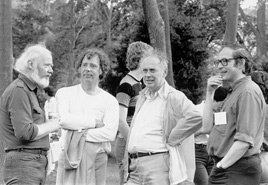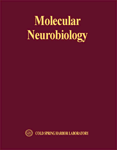|
XLVIII: Molecular Neurobiology 1983 |
|
|

|
From left: Dr. Michael Raftery, Dr. Robert Stroud, Dr. James Watson, Dr. Klaus Weber SYMPOSIUM SYNOPSIS LIST OF PARTICIPANTS CONTENTS OF SYMPOSIUM VOLUME PHOTOGRAPHS PUBLISHED VOLUME  |
Molecular Neurobiology
1983
Symposium Synopsis
Organizer: J.D. Watson, R. McKay
Ever since the genetic code was solved in 1966, the brain and the phenomena it oversees—perception, memory, and thinking—have stood out like Himalayan peaks to the world of molecular biologists. Until very recently, however, most of us have believed that we have little unique to offer those long professionally involved in neurobiological phenomena and that the brain in particular was far beyond our capabilities. Those few molecular biologists who did move into neurobiology we have in the past regarded as frightfully brave or recklessly silly.
Apparently particularly hopeless was the approach that should be the most natural to us, that of focussing first on the structure and functioning of the molecules out of which the nerve cells are made. Although such research of itself could become fun to do, for many years the chances seemed nil that it would be through molecular biology that the intimate secrets of the brain would fall out. So an audacious few of us had moved into the fields of psychophysics, hoping that bouts of hard thinking could do the job. But here again the odds that fundamental revelations would quickly emerge seemed painfully low.
Today, however, we sense a new mood among those molecular biologists who gaze upwards toward the brain. By using recombinant DNA, monoclonal antibodies, and the facts of receptor biochemistry to the fullest, we should have a fighting chance to understand the uniqueness of nerve cells and the ways they come together to form functional networks. To mark this new mood, we decided to hold the 48th Symposium on Molecular Neurobiology.
In putting together this meeting, we received excellent advice from many colleagues. We wish to thank Eric Kandel and Charles Stevens, both long associated with the Cold Spring Harbor summer courses in neurobiology. The final result was a program of 91 speakers that started with an introduction by Max Cowen and concluded with a summary by Eric Kandel. The total attendance was 233 participants, all of whom thought that this Symposium would be long remembered as a decisive turning point in the development of neurobiology.
Our Meetings Office—Gladys Kist, Barbara Ward, Maureen Berejka, Merilyn Simkins—with their usual cheerful competence made sure that everyone was well received, well fed, and well housed. Herb Parsons expertly oversaw the audio-visual aspects of the meeting.
Financial support for this meeting was provided by the National Institutes of Health, National Science Foundation, and the Department of Energy. These much-needed funds enabled us to cover the meeting costs of our invited speakers and to provide travel expenses for many of our overseas speakers.
This year we have worked especially hard to publish these volumes in the same year as our June meeting, an interval of less than 7 months. So we have been firm in sticking to our requests that the manuscripts must be handed in during the Symposium week or immediately after. We note the great cooperation we have received from our speakers, a happy situation to which we must also credit the friendly persistence and speedy editing of Judith Cuddihy, Dorothy Brown, Karen Sundin, and Joan Ebert of our Publications Department, which continues to be ably headed by Nancy Ford.
— Jan A. Witkowski
Search images: